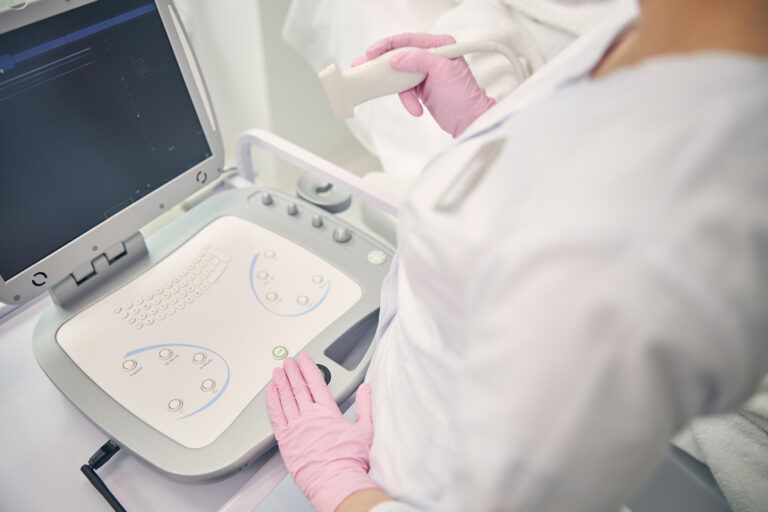What is Transvaginal Scan (TVS)?
A transvaginal scan, also known as a transvaginal ultrasound, is a non-invasive procedure that utilizes high-frequency sound waves to create detailed images of the pelvic organs. This imaging technique is commonly used to diagnose and monitor various conditions related to the female reproductive organs, such as pelvic pain, infertility, and abnormal exam results.
Transvaginal scans offer several advantages over other imaging methods. Firstly, they provide more detailed images compared to transabdominal scans, allowing for better visualization of the pelvic organs. This level of detail can aid in the accurate diagnosis and treatment of conditions affecting the reproductive system.
The procedure itself is safe, effective, and considered non-invasive. It involves the insertion of a lubricated ultrasound probe into the vagina, which captures real-time images of the pelvic organs. These images are displayed on a screen and can be monitored by the healthcare professional performing the scan. It’s important to note that while the procedure is generally not painful, some discomfort or slight pain may be experienced during probe insertion.
Transvaginal scans are an essential tool in the field of gynecology and obstetrics. They enable healthcare professionals to obtain detailed images of the pelvic organs, providing valuable information for diagnosis and treatment. By utilizing high-frequency sound waves, transvaginal scans offer a safe and non-invasive method to assess the reproductive system. Let’s delve deeper into the definition of transvaginal scans and the procedure involved.
Transvaginal Scan: Definition and Procedure
A transvaginal scan is a non-invasive procedure that uses high-frequency sound waves to create detailed images of the pelvic organs. This imaging technique is particularly useful in examining the uterus, cervix, fallopian tubes, and ovaries. By inserting a lubricated ultrasound probe into the vagina, healthcare professionals can capture real-time images of these organs for further analysis and evaluation.
The procedure itself is relatively straightforward. The patient lies on an examination table with their knees bent, which allows for easier access to the vagina. A lubricated ultrasound probe, slightly larger than a tampon, is gently inserted into the vagina. This probe emits high-frequency sound waves that bounce off the pelvic organs, creating detailed images on a screen. The healthcare professional can then examine these images in real-time, monitoring the health and structure of the reproductive organs.
It is essential to note that while transvaginal scans are generally not painful, some individuals may experience slight discomfort or pressure during the probe insertion. This discomfort is temporary and typically subsides quickly. The entire procedure usually takes around 15-30 minutes, and there are no known risks or side effects associated with transvaginal scans.
Transvaginal scans are a valuable diagnostic tool for various conditions affecting the female reproductive system. They provide healthcare professionals with detailed images, enabling them to identify abnormalities, monitor the progress of pregnancy, and investigate concerns such as pelvic pain or infertility. Now, let’s explore the reasons why individuals may undergo a transvaginal scan.
Reasons for Undergoing a Transvaginal Scan
Transvaginal scans are performed for various reasons, ranging from diagnosing specific conditions to monitoring the health of the reproductive system. Let’s explore some of the common reasons why individuals may undergo a transvaginal scan.
Diagnosis of Various Conditions and Abnormalities
One of the primary reasons for undergoing a transvaginal scan is to diagnose and assess conditions affecting the female reproductive organs. Pelvic pain, for example, can be caused by various factors, including ovarian cysts, fibroids, or other abnormalities in the pelvic region. Transvaginal scans can help identify the underlying cause of pelvic pain, facilitating appropriate treatment.
Infertility is another area where transvaginal scans play a crucial role. These scans assist in assessing the reproductive organs, such as the uterus and ovaries, helping healthcare professionals identify potential causes of infertility. By visualizing the structures and evaluating their health and functionality, transvaginal scans provide valuable insights that aid in determining appropriate fertility treatments.
In addition, transvaginal scans are commonly used to investigate abnormal exam results, such as abnormal Pap smear or other test findings. They enable healthcare professionals to further evaluate and investigate these abnormalities, leading to a more accurate diagnosis and appropriate treatment plan.
Pregnancy Monitoring
Transvaginal scans are invaluable in monitoring the progress of pregnancy. They play a vital role in assessing the growth and development of the fetus, ensuring that everything is progressing as it should. Transvaginal scans are often used in early pregnancy to confirm the presence of a viable fetus, detect any potential abnormalities, and estimate gestational age.
These scans also enable healthcare professionals to assess the placenta, which plays a critical role in supporting the developing fetus. The transvaginal approach provides detailed images of the placenta, allowing for the identification of any abnormalities or potential complications that may require medical attention.
By offering comprehensive insights into the health and development of the reproductive system, transvaginal scans provide healthcare professionals with the necessary information to make informed decisions regarding treatment and care.
To understand the benefits of transvaginal scans fully, it is important to compare them to transabdominal scans, another commonly used imaging technique. Let’s explore the advantages and limitations of transvaginal scans in comparison.
Benefits and Limitations of Transvaginal Scans
Transvaginal scans offer several benefits compared to other imaging methods, making them a valuable tool in diagnosing and monitoring conditions related to the female reproductive organs. Let’s delve into the advantages and limitations of transvaginal scans.
Benefits
One of the significant advantages of transvaginal scans is the detailed imaging they provide. By inserting the ultrasound probe into the vagina, healthcare professionals can obtain highly detailed images of the pelvic organs. This level of detail allows for better visualization and assessment of the reproductive system, aiding in accurate diagnosis and treatment planning.
Transvaginal scans are also considered safe and radiation-free. Unlike other imaging methods, such as X-rays or computed tomography (CT) scans, transvaginal scans utilize high-frequency sound waves to generate images. This non-invasive approach ensures the safety of both non-pregnant individuals and pregnant women.
Another notable benefit of transvaginal scans is the absence of reported risks or side effects associated with the procedure. It is a well-tolerated imaging technique, and any discomfort experienced during the probe insertion is typically minimal and temporary. This makes transvaginal scans a reliable and safe option for diagnosing and monitoring conditions related to the female reproductive organs.
Limitations
While transvaginal scans offer numerous benefits, it is essential to acknowledge their limitations as well. One potential limitation is the discomfort or slight pain that some individuals may experience during the probe insertion. However, it is important to note that this discomfort is temporary and generally outweighed by the diagnostic benefits of the procedure.
Another potential limitation is the possibility of minor bleeding due to the displacement of blood in the vagina during the scan. However, this bleeding is typically minimal and poses no significant risks or complications.
By understanding the benefits and limitations of transvaginal scans, individuals can make informed decisions regarding their healthcare and participate actively in the diagnostic process. Now, let’s explore how transvaginal scans compare to abdominal scans, another commonly used imaging technique.
Transvaginal VS Abdominal Scans
Both transvaginal scans and abdominal scans are utilized to assess the pelvic region and reproductive organs. Each method has its own advantages and considerations, making them suitable for different clinical situations.
Transvaginal Scans
Transvaginal scans involve the insertion of a lubricated ultrasound probe into the vagina to capture detailed images of the pelvic organs. This approach provides a closer and more detailed view of the reproductive system compared to transabdominal scans. Transvaginal scans offer enhanced visualization and assessment of the uterus, cervix, fallopian tubes, and ovaries, allowing for accurate diagnosis and monitoring of various conditions.
Another advantage of transvaginal scans is that they generally do not require any specific preparation, such as having a full bladder, before the procedure. This eliminates the need for patients to follow any specific dietary or fluid intake instructions, simplifying the process.
Abdominal Scans
Abdominal scans, on the other hand, provide a broader view of the abdomen and pelvic region. While they may not offer the same level of detail as transvaginal scans, they are still useful in assessing certain conditions and abnormalities. Abdominal scans often require specific preparation, such as having a full bladder, to optimize image quality. This preparation may involve drinking a certain amount of water before the scan to ensure a clear visualization of the pelvic organs.
The choice between a transvaginal scan and an abdominal scan depends on the clinical situation and the judgment of the healthcare professional. In many cases, both types of scans may be used in combination to gather comprehensive information about the pelvic organs, allowing for a more accurate diagnosis and effective treatment planning.
Now that we have discussed the procedure, reasons for undergoing a transvaginal scan, and the benefits and limitations of this imaging technique, it is important to understand how to prepare for a transvaginal scan.
Preparing for a Transvaginal Scan
Preparing for a transvaginal scan is relatively straightforward. While no specific preparation is usually required, there are a few things individuals can do to ensure a successful examination.
Firstly, it is generally recommended to empty the bladder before the transvaginal scan. This helps to ensure optimal imaging quality and allows for a clearer visualization of the pelvic organs. By emptying the bladder, any potential interference with the scan can be minimized, resulting in more accurate and reliable imaging.
Furthermore, for individuals who are on their period, it is advisable to remove a tampon before the procedure. This ensures that the ultrasound probe can be inserted without any obstructions or discomfort. By following these simple steps, individuals can help facilitate a smooth and effective transvaginal scan.
Analysis and Discussion of Transvaginal Ultrasound Results
The results of a transvaginal ultrasound are typically analyzed by a radiologist, a medical professional specializing in interpreting medical images. The radiologist carefully evaluates the images captured during the scan and prepares a detailed report outlining their findings and observations. This report is then shared with the referring doctor, who discusses the results with the patient and provides appropriate guidance or recommendations based on the findings.
It is crucial for patients to discuss the results of the transvaginal ultrasound with their referring doctor to gain a comprehensive understanding of their implications. The referring doctor, who is familiar with the patient’s medical history and overall healthcare needs, can provide valuable insights and guidance based on the radiologist’s report. This collaborative approach ensures that patients receive the necessary information and support to make informed decisions regarding their healthcare.
When to visit Klinik Azurose for TVS Scan?
Transvaginal scans are a valuable tool in diagnosing and monitoring conditions related to the female reproductive organs. They offer detailed imaging, are safe and non-invasive, and provide essential information for accurate diagnosis and appropriate treatment. Whether used to investigate pelvic pain, assess infertility, or monitor pregnancy, transvaginal scans play a crucial role in women’s healthcare.
By understanding the procedure, its benefits, and the significance of the results, individuals can actively participate in their own healthcare journey and make informed decisions with their healthcare providers. Transvaginal scans empower individuals to take control of their reproductive health and ensure the best possible outcomes for themselves and their families.





